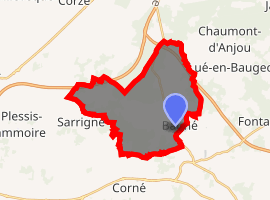Bauné
Bauné is a former commune in the Maine-et-Loire department in western France. On 1 January 2016, it was merged into the new commune of Loire-Authion.[2]
Bauné | |
|---|---|
Part of Loire-Authion | |
Location of Bauné 
| |
 Bauné  Bauné | |
| Coordinates: 47°29′59″N 0°19′07″W | |
| Country | France |
| Region | Pays de la Loire |
| Department | Maine-et-Loire |
| Arrondissement | Angers |
| Canton | Angers-7 |
| Commune | Loire-Authion |
| Area 1 | 20.99 km2 (8.10 sq mi) |
| Population (2017)[1] | 1,733 |
| • Density | 83/km2 (210/sq mi) |
| Time zone | UTC+01:00 (CET) |
| • Summer (DST) | UTC+02:00 (CEST) |
| Postal code | 49140 |
| Elevation | 22–76 m (72–249 ft) (avg. 28 m or 92 ft) |
| 1 French Land Register data, which excludes lakes, ponds, glaciers > 1 km2 (0.386 sq mi or 247 acres) and river estuaries. | |
Population
| Year | Pop. | ±% |
|---|---|---|
| 1793 | 1,254 | — |
| 1800 | 1,196 | −4.6% |
| 1806 | 1,317 | +10.1% |
| 1821 | 1,180 | −10.4% |
| 1831 | 1,197 | +1.4% |
| 1836 | 1,209 | +1.0% |
| 1841 | 1,109 | −8.3% |
| 1846 | 1,081 | −2.5% |
| 1851 | 1,047 | −3.1% |
| 1856 | 1,090 | +4.1% |
| 1861 | 1,038 | −4.8% |
| 1866 | 1,014 | −2.3% |
| 1872 | 1,002 | −1.2% |
| 1876 | 983 | −1.9% |
| 1881 | 952 | −3.2% |
| 1886 | 983 | +3.3% |
| 1891 | 932 | −5.2% |
| 1896 | 890 | −4.5% |
| 1901 | 884 | −0.7% |
| 1906 | 807 | −8.7% |
| 1911 | 805 | −0.2% |
| 1921 | 689 | −14.4% |
| 1926 | 712 | +3.3% |
| 1931 | 714 | +0.3% |
| 1936 | 722 | +1.1% |
| 1946 | 641 | −11.2% |
| 1954 | 735 | +14.7% |
| 1962 | 615 | −16.3% |
| 1968 | 563 | −8.5% |
| 1975 | 502 | −10.8% |
| 1982 | 901 | +79.5% |
| 1990 | 1,142 | +26.7% |
| 1999 | 1,290 | +13.0% |
| 2006 | 1,419 | +10.0% |
| 2009 | 1,570 | +10.6% |
gollark: > We've added a note in the Readme that Wine is not supported and improved the error returned, so I think there is anything else to do here.Impressive.
gollark: FEAR CPU cacheoforms.
gollark: I doubt it. You would make the CPU caches very unhappy.
gollark: Oh, the JavaScriptoidal form.
gollark: Functors are an utterly different concept.
References
- Téléchargement du fichier d'ensemble des populations légales en 2017, INSEE
- Arrêté préfectoral Archived 2015-12-08 at the Wayback Machine 7 December 2015
| Wikimedia Commons has media related to Bauné. |
This article is issued from Wikipedia. The text is licensed under Creative Commons - Attribution - Sharealike. Additional terms may apply for the media files.